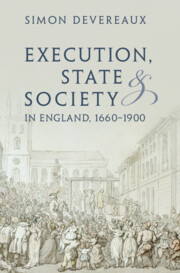188 results
The Communal Roots of Mexico’s Maquila Industry: Urbanization, Land, and Inequality in Ciudad Juárez, 1960–2000
-
- Journal:
- Latin American Research Review ,
- Published online by Cambridge University Press:
- 03 June 2024, pp. 1-24
-
- Article
-
- You have access
- Open access
- HTML
- Export citation
18 - Sex in Lagos from the Mid-Nineteenth to the Mid-Twentieth Century
-
-
- Book:
- The Cambridge World History of Sexualities
- Published online:
- 26 April 2024
- Print publication:
- 16 May 2024, pp 379-401
-
- Chapter
- Export citation
5 - Two Paths
-
- Book:
- China's Age of Abundance
- Published online:
- 28 March 2024
- Print publication:
- 04 April 2024, pp 137-167
-
- Chapter
- Export citation
7 - Aftermath
-
- Book:
- China's Age of Abundance
- Published online:
- 28 March 2024
- Print publication:
- 04 April 2024, pp 202-239
-
- Chapter
- Export citation
4 - Ascendance
-
- Book:
- China's Age of Abundance
- Published online:
- 28 March 2024
- Print publication:
- 04 April 2024, pp 102-136
-
- Chapter
- Export citation
Toward achieving smart cities in Africa: challenges to data use and the way forward
-
- Journal:
- Data & Policy / Volume 6 / 2024
- Published online by Cambridge University Press:
- 13 March 2024, e13
-
- Article
-
- You have access
- Open access
- HTML
- Export citation
An Imperial Adventus into a City of Warehouses: History, Modernity, and Urbanity in the Symbolic and Material Construction of Hamburg's Free Port
-
- Journal:
- Central European History , First View
- Published online by Cambridge University Press:
- 07 March 2024, pp. 1-27
-
- Article
-
- You have access
- Open access
- HTML
- Export citation
11 - Population of the Iberian Peninsula in the Early Modern Period: A Comparative and Regional Perspective
- from Part II - Globalization and Enlightenment, 1500–1800
-
-
- Book:
- An Economic History of the Iberian Peninsula, 700–2000
- Published online:
- 22 February 2024
- Print publication:
- 29 February 2024, pp 278-309
-
- Chapter
- Export citation
19 - Population Growth, Composition and Educational Levels
- from Part III - Industrialization and Catching Up, 1800–2000
-
-
- Book:
- An Economic History of the Iberian Peninsula, 700–2000
- Published online:
- 22 February 2024
- Print publication:
- 29 February 2024, pp 496-518
-
- Chapter
- Export citation
Using paleopathology to provide a deep-time perspective that improves our understanding of one health challenges: Exploring urbanization
-
- Journal:
- Research Directions: One Health / Volume 2 / 2024
- Published online by Cambridge University Press:
- 08 February 2024, e5
-
- Article
-
- You have access
- Open access
- HTML
- Export citation
A monumental Archaic complex on the Sacra Via: a new interpretation of the domestic remains on the north Palatine slope
-
- Journal:
- Journal of Roman Archaeology / Volume 36 / Issue 2 / December 2023
- Published online by Cambridge University Press:
- 09 January 2024, pp. 332-367
- Print publication:
- December 2023
-
- Article
-
- You have access
- Open access
- HTML
- Export citation
Chapter 3 - Performing on the Periphery: Military–Theatrical Experiences at the Théâtre de la Marine (Brest) and the Comédie du Cap (Cap-Français)
-
- Book:
- Theater, War, and Revolution in Eighteenth-Century France and Its Empire
- Published online:
- 09 November 2023
- Print publication:
- 23 November 2023, pp 92-139
-
- Chapter
- Export citation
20 - Popular Movements in Early Modern Japan
- from Part III - Social Practices and Cultures of Early Modern Japan
-
-
- Book:
- The New Cambridge History of Japan
- Published online:
- 15 January 2024
- Print publication:
- 23 November 2023, pp 659-688
-
- Chapter
- Export citation
1 - Introduction
-
- Book:
- Execution, State and Society in England, 1660–1900
- Published online:
- 12 October 2023
- Print publication:
- 26 October 2023, pp 1-29
-
- Chapter
- Export citation
Analysis of a 131-year longitudinal dataset of the Eurasian otter Lutra lutra in Hong Kong: implications for conservation
-
- Article
-
- You have access
- Open access
- HTML
- Export citation
Chapter 1 - A Case of a Rapidly Aging Society and Its Dementia Population
- from Part I - Approaches to Society within the Brain
-
-
- Book:
- Society within the Brain
- Published online:
- 28 September 2023
- Print publication:
- 12 October 2023, pp 11-49
-
- Chapter
- Export citation
5 - Etruscan Urbanization, c. 700–300 bc
-
-
- Book:
- In the Footsteps of the Etruscans
- Published online:
- 12 October 2023
- Print publication:
- 12 October 2023, pp 130-175
-
- Chapter
- Export citation

Execution, State and Society in England, 1660–1900
-
- Published online:
- 12 October 2023
- Print publication:
- 26 October 2023
3 - Prison Labor and the Politics of Slavery
-
- Book:
- Policing Freedom
- Published online:
- 03 August 2023
- Print publication:
- 17 August 2023, pp 153-196
-
- Chapter
- Export citation
Introduction
-
- Book:
- Africa's Urban Youth
- Published online:
- 10 August 2023
- Print publication:
- 10 August 2023, pp 1-12
-
- Chapter
- Export citation



